Fire turned the Edgartown Playhouse into a furious inferno Monday night, and three hours after the discovery of the blaze the large, forty-one year old building was completely devastated, despite the long and tireless efforts of firefighters from three towns who poured tons and tons of water into the theatre.
The fire was discovered by Benjamin L. Hall, who lives at the rear of the theatre and who saw from a window in his house the flames flickering in the window of the backstage room. Mr. Hall had hardly turned in the alarm - he said the time was about five minutes past eight - when the flames began to burst out of the roof, principally through the cupola-like ventilators.
Some time previous to Mr. Hall’s discovery, though, passers-by on Main street had been able to smell the pungent odor of smoke but did not know the source.
Started in Backstage Area
It was apparent that the fire started in the backstage area which was used for the storage of many articles including a number of ancient flats used in stage settings, as well as paint cans, and the blaze moved persistently from the back of the building to the front, as could be witnessed easily from the outside as each of the ventilators on the roof, one by one, became enveloped in flames.
Lieut. George Killen of Chatham, a member of the state fire marshal’s office, came to the Island the next day to investigate, at the request of Chief Silva. His investigation revealed that the fire did begin in the storage room, but the origin is still undetermined. Lieutenant Killen spoke to witnesses who said that on other days young boys had been seen coming out of the cellar door of the theatre, but there was no evidence to be found that the fire was the work of incendiaries.
The fire at the front seemed to be the most stubborn, there being more in that area to burn. The attention of the main body of firefighters was concentrated on that part of the building for nearly two hours after the rest had been brought under control. A battery of hose was trained on the building from Main street, from perches on the Vose insurance building, and from almost directly above the roof of the burning building itself, where an Oak Bluffs fireman held a hose with a wide-spray nozzle atop the extended ladder of that town’s new aerial ladder truck.
When the alarm sounded in Edgartown, a few more than a hundred were just getting into their cars at the Edgartown school, following a special town meeting held there, so much of the population was mobile at the time. Many members of the fire department, including Chief William P. Silva, were in Oak Bluffs, though, attending a meeting of the Knights of Columbus.
The assistant chief, Antone M. Silva Jr. was in charge of the early organization of firemen and fire trucks. He said that when the apparatus first rolled to the scene of the fire there were hardly more than two men per truck, but others soon arrived. Noting the extent of the fire, and that Assistant Chief Silva had his hands full, the chairman of the board of selectmen, Edward W. Vincent, put in the call requesting the assistance of the fire departments of Oak Bluffs and Tisbury.
Before too many minutes had passed, a full complement of men and pieces of apparatus was attacking the blazing building from all sides.
At one time there were seven streams of water directed at the building from Main street alone. There were eight trucks, three of them stationed at the harborfront to pump sea water up the street, the others attached to hydrants within an area of four blocks square.
The most amazing piece of equipment, of course, was the Oak Bluffs aerial ladder truck, which was stationed in the parking lot next to the theatre and behind the Vose building. From that point its mechanically controlled extension ladder was able to a man and a hose directly above the burning building itself, where the water could be trained with accuracy on the flames.
Five Took Turns
This truck was operated by Amos Sylvia, an assistant engineer of the Oak Bluffs department, and he attended to the relieving of the men who took turns at the top of the ladder. There were five men who took turns at the top, Dennis Alley, Ronald Rose, Antone Maseda, William Anderson, and Peter Regan Jr., whose efforts, besides being tremendously effective, also provided a thrilling sight for the spectators.
The spectators were many, word of the fire apparently having spread to all parts of the Island. The hundreds who gathered to watch, awestruck by the spectacular fire, were orderly and demonstrated an excellent cooperation with the firefighters.
The fight was principally one of containment since it was apparent from the beginning that the fire must have been smoldering for quite a while before it was discovered, and that the interior of the building was already lost. A soft and comparatively gentle breeze blew the smoke and sparks toward Main street and toward the adjacent building to the east, Edgartown Shops. This building, formerly the home and shop of Edwin B. Gentle, has in the past year been extensively remodeled, and the proprietor and owner, Mrs. Irene Hall Spirit, had already made many of the preparations for opening early this month. From the beginning of fighting the fire, an almost constant stream of water was kept on the Edgartown Shops building to prevent the fire from spreading to it. That precaution, which was aided considerably by the fact that the walls of the theatre are stucco, saved the building, which nevertheless had minor water and smoke damage.
Moon Hung in Branches
An odd sight resulted from the fact that during the fire the moon, two days past full, chose to rise up behind Chappaquiddick and seemed to hang suspended in the branches of the tremendous elm tree in front of the movie house, turning from white to various shades of orange as smoke billowed across its face.
Spectators could not help surmising how much more disastrous the fire would have been if it had broken out several hours earlier in the day, which was distinguished, even by the well standards of a Vineyard April, by uncommonly strong and capricious winds. It was generally agreed that the containment of the fire, no easy matter as it was, would have been next to impossible in heavy wind.
The smooth coordination of the three separate fire departments was also remarked upon. Edgartown had its three trucks on the scene, Oak Bluffs had three and about forty-five men, and Tisbury had two and about thirty men. Two of the Oak Bluffs men were injured. Thomas Ciancio had a wrist injured by a blow, and Harry Abdelnour Jr. sustained cuts on his hands from broken glass he was unable to see in the dark.
Fire Chief Nelson Amaral was in command of the Oak Bluff force and Chief Lawrence Winterbottom of the Tisbury apparatus and men.
The long hours of strenuous labor put in by the firemen, many of whom were liberally doused with water, were relieved through the efforts of two groups of people who organized themselves to provide refreshments and sustenance.
Coffee in Quantity
Mrs. Kenneth W. Grant, the Red Cross disaster chairman for Edgartown, assisted by her daughter in law, Mrs. Jared Grant, Mrs. David Hamblen and Mrs. Carmen Ciancio, dispensed four urnsful of coffee to the firemen, carrying the welcome brew around in large containers. The coffee was made in the Coffee Shop which Robert J. Carroll, the owner, and Mrs. Daniel Bryant, a waitress, re-opened for the duration of the firefighting. The coffee was donated to the Red Cross by Mr. Carroll.
Coffee and sandwiches were also served from the brand new kitchen at the Edgartown Methodist Church, with Mrs. J. Gordon Allen, the wife of the minister, heading a task force consisting of Miss Miriam Butler, Mr. and Mrs. Gustav C. Wuerth, Miss Marilyn Jackson and David Allen, who worked with provisions augmented by donations from Herbert R. Mercier’s grocery and from Mrs. John Bauer.
When the fire was finally out and the building was reasonably safe to enter, Mr. Hall, who is the son of the theatre’s active head, Alfred Hall, investigated the premises and found that the projection booth, which is sheathed in an asbestos material, had come through the holocaust in reasonably good condition. He removed a number of lenses which he valued at about $1,000 and which, after a great deal of cleaning and polishing, turned out to be unharmed. He said he thought the projectors themselves were also in working order.
Charred Tangle of Debris
There was very little else in the building that was not either damaged or totally destroyed. The next morning the interior could be seen - through a large aperture in the back created by the collapse of about a third of the rear wall - to be nothing more than a charred tangle of debris underneath which the rows of theatre seats ranged forlornly.
Half of the proscenium arch had crashed to the ground, and there was hardly a hint that the auditorium once possessed wall panels of plum colored brocade, faded to be sure but still evocative of a certain elegance.
The theatre is one of four on the Island owned by the Vineyard Theatre Trust, of which Reuben Hall and Miss Olive Hillman are trustees, and of which Alfred Hall, who was vacationing in Florida, is the operating head. He was notified of the fire by telephone shortly after it was discovered, and was in communication with various people in town throughout the course of the fire and afterwards. It was learned that he planned to drive back to the Island immediately.
Mr. Hall said to his son, “Don’t let people say Edgartown will be without movies this summer - they may be surprised.” Movie going is one of the most popular evening pastimes during the summer season, and the presentation of matinée film showings for the children on rainy days is often relied upon to preserve the sanity of parents, nursemaids and baby sitters.
The fire was considered to be virtually extinguished by 11 p.m., and then it was time for the three fire departments to begin clean-up operations. The chilled spectators had thinned out considerably by then, but those who stayed saw a performance that for efficiency fully matched the more vigorous and dramatic task of fighting the fire. Main street in particular was possessed of such a welter of hose lines that a layman would have ventured it would take days to straighten the mess out.
But the street was cleared within a relatively few minutes. The huge theatre elm, which had been liberally dosed with salt water during evening, was sprayed down with fresh water, and Cornelius Silva stood by for the rest of the night with a charged line, to guard against any belated outbreak of flame.





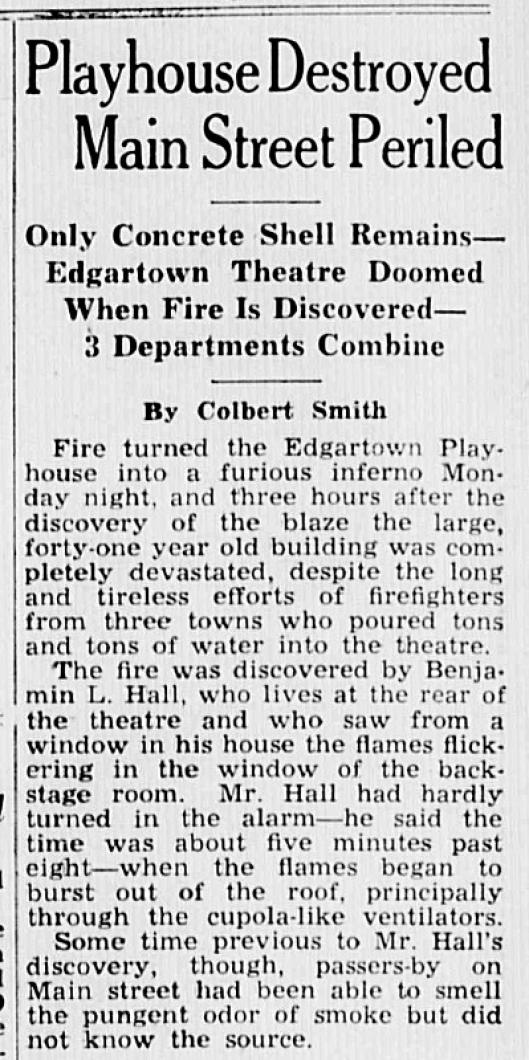
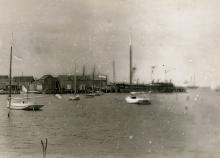
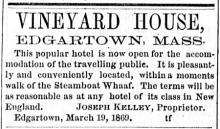
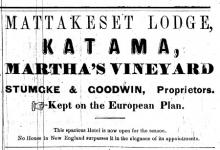
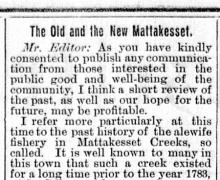
Comments